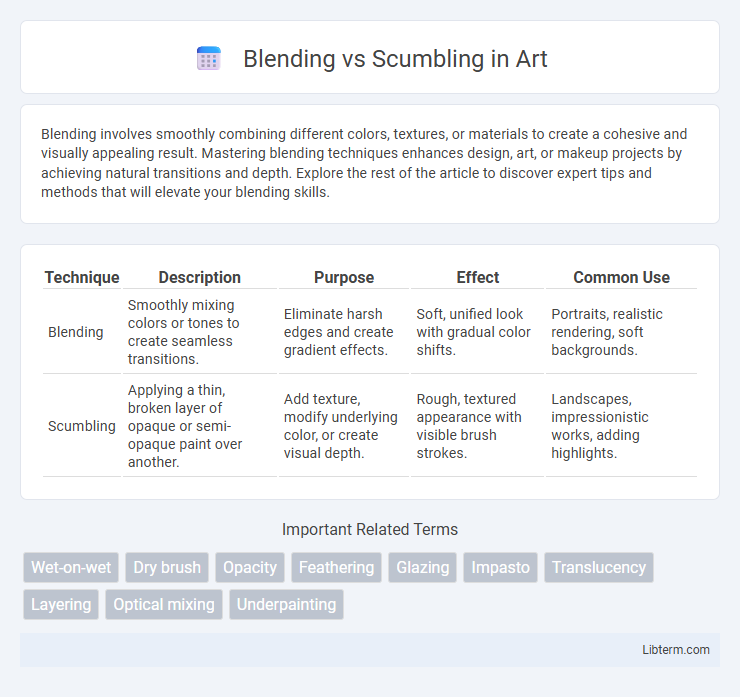Blending involves smoothly combining different colors, textures, or materials to create a cohesive and visually appealing result. Mastering blending techniques enhances design, art, or makeup projects by achieving natural transitions and depth. Explore the rest of the article to discover expert tips and methods that will elevate your blending skills.
Table of Comparison
| Technique | Description | Purpose | Effect | Common Use |
|---|---|---|---|---|
| Blending | Smoothly mixing colors or tones to create seamless transitions. | Eliminate harsh edges and create gradient effects. | Soft, unified look with gradual color shifts. | Portraits, realistic rendering, soft backgrounds. |
| Scumbling | Applying a thin, broken layer of opaque or semi-opaque paint over another. | Add texture, modify underlying color, or create visual depth. | Rough, textured appearance with visible brush strokes. | Landscapes, impressionistic works, adding highlights. |
Introduction to Blending and Scumbling
Blending and scumbling are essential painting techniques used to achieve different textures and effects on canvas. Blending involves smoothly merging colors or tones to create a gradient or soft transition, often used to depict realistic shading and depth. Scumbling applies a thin, opaque, or semi-opaque layer of paint with a dry brush, producing a textured, broken color effect that enhances visual complexity.
Defining Blending: Technique and Purpose
Blending is a painting technique where colors are smoothly merged to create seamless transitions and soft gradients, enhancing depth and realism. Artists use blending to eliminate harsh edges, allowing hues to flow naturally, which is essential in portraiture and landscape art for lifelike effects. This method often involves tools like brushes, sponges, or fingers to achieve the desired smoothness and tonal harmony.
Understanding Scumbling: Methods and Effects
Scumbling is a painting technique where a thin, opaque layer of lighter or contrasting color is applied with a dry brush over a dry underpainting, creating a textured, broken color effect that enhances depth and visual interest. Unlike blending, which smoothly transitions colors, scumbling preserves underlying brushstrokes and surface texture, making it ideal for effects like atmospheric haze or rough surfaces. Mastery of scumbling involves controlling brush pressure and paint dilution to achieve subtle color variations and dynamic light reflections.
Key Differences Between Blending and Scumbling
Blending involves smoothly merging colors or tones to create seamless transitions, often used for realistic shading and gradients. Scumbling applies a layer of broken, semi-transparent color over another to produce texture and visual depth without smooth transitions. The key difference lies in blending's focus on smoothness and uniformity versus scumbling's emphasis on texture and layered color effects.
Materials and Tools Required for Each Technique
Blending requires soft brushes or blending stumps, smooth paper or canvas, and mediums like linseed oil for oils or water for watercolors to seamlessly merge colors. Scumbling involves using stiff bristle brushes or coarse sponges on textured surfaces, often with thicker paint consistency or dry media like pastels or charcoal to create broken, textured layers. Both techniques demand specific tools that influence the final visual effect, highlighting the importance of selecting proper materials for desired artistic outcomes.
Step-by-Step Guide to Blending in Painting
Blending in painting involves gradually mixing colors on the canvas to create smooth transitions and realistic shading, achieved by softly combining adjacent hues using a dry brush, sponge, or finger while the paint is still wet. Key steps include applying base colors, working wet-on-wet for seamless integration, and using fine brush strokes or circular motions to merge edges without harsh lines. Mastery of blending enhances depth and dimension in portraits and landscapes, contrasting with scumbling, which layers broken, textured strokes for a more expressive, translucent effect.
Step-by-Step Guide to Scumbling in Painting
Scumbling in painting involves applying a thin, opaque layer of lighter or contrasting color over a dried darker layer to create texture and depth, enhancing visual interest. Begin by letting the base layer dry completely, then lightly drag a dry brush with minimal paint across the surface using small, circular or back-and-forth motions to achieve a broken, textured effect. This technique is especially effective for adding highlights, soft transitions, and atmospheric elements, distinguishing it from the smoother, more uniform transitions of blending.
When to Choose Blending vs Scumbling
Choose blending when aiming for smooth transitions and realistic shading in artwork, as it softens edges and unifies colors seamlessly. Opt for scumbling to create texture, depth, or an illusion of movement by applying broken, semi-transparent layers of color that allow underlying tones to show through. Blending suits detailed, polished finishes, whereas scumbling enhances expressiveness and atmospheric effects.
Common Mistakes in Blending and Scumbling
Common mistakes in blending include over-mixing colors, which causes a muddy or dull appearance that lacks vibrancy and dimensionality. In scumbling, artists often apply too thick a layer, resulting in uneven texture and loss of underlying detail, or use colors that are too similar, reducing the intended contrast effect. Both techniques require controlled pressure and strategic color selection to maintain clarity and desired visual impact.
Expert Tips for Mastering Both Techniques
Mastering blending requires soft, circular motions to seamlessly merge colors, creating smooth gradients ideal for realistic effects. Scumbling demands a light, broken stroke technique, layering paint with varying opacity to achieve texture and depth without losing underlying details. Experts recommend practicing control over brush pressure and paint dilution to switch fluidly between the two techniques for dynamic, expressive artwork.
Blending Infographic

 libterm.com
libterm.com